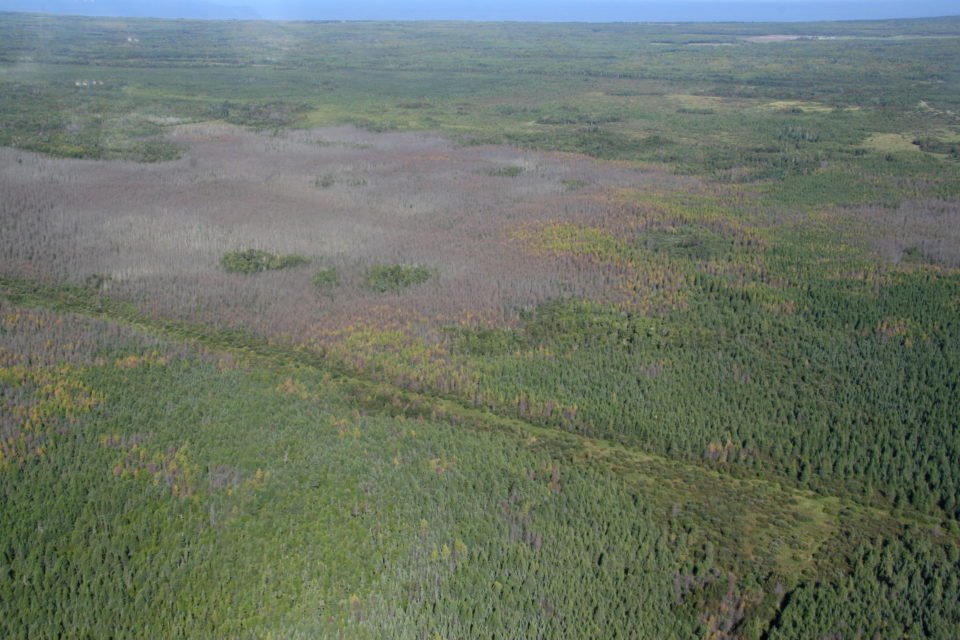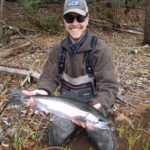The only time most Minnesotans think about tamaracks is in autumn, when, in the words of Aldo Leopold, the trees turn “smoky gold.” Also known as the American larch, the tamarack is our only needle-bearing deciduous tree. After the tamaracks turn smoky gold, they drop their needles and spend the winter bare-limbed.
It’s normal to see bare tamaracks when there is snow on the ground, but abnormal after spring green-up. Unfortunately, bare tamaracks year-round have become a common sight in parts of northern Minnesota. An outbreak of a native insect, the eastern larch beetle, began around 2000 continues unabated. So far, it has affected about 835 square miles of Minnesota forest.
“That’s the equivalent to the surface area of Upper and Lower Red, Mill Lacs and Leech lakes combined,” says Brian Schwingle, tree insect and disease specialist for the DNR Forestry Division.
Of that area, the beetles have wiped out tamaracks across 220 square miles, which is roughly the size of Mille Lacs. The outbreak is a big deal in terms of forest health, but hasn’t received much attention beyond loggers and foresters for three reasons. First, most of the outbreak has occurred in a remote portion of the state: Lake of the Woods, western Koochiching and Beltrami counties. There, tamaracks grow in vast bogs, where few people go. They are also a tree with limited commercial value, primarily used for kraft pulp, as well as for biomass, fuel wood and to produce a biochemical product. But limited markets don’t reduce the value of tamarack to the state’s forests. Minnesota has more tamarack than any other state, covering about 1.4 million acres, or eight percent of the state’s forests. This represents about one half of the tamarack found in the Lower 48.
The “whys” of the outbreak aren’t completely understood. University of Minnesota researchers found that in Minnesota the eastern larch beetle sometimes produces two generations each year. Prior to this finding, no one had observed the beetle ever making more than one generation per year. This possibly is happening because the bugs benefit from earlier spring thaws and later fall freezes due to warming climatic conditions. The beetles favor larger trees. Schwingle said there is no history of previous larch beetle outbreaks lasting over six years or starting after no apparent stressing event (like defoliation or severe drought).
“What’s scary is it (the outbreak) just keeps going,” he said. “There is no indication of it slowing down and it is very widespread.”
As a native species, the eastern larch beetle isn’t likely to freeze out during winter cold spells. The adult beetles can stand temps as low as -43F and larvae survive to -56F, but that would only happen if they are under the bark above the snow line. Sometimes, well over half of the overwintering beetles are under bark towards the base of the trunk, well insulated by snowpack. In contrast, the emerald ash borer, an invasive pest, starts to die out at -20F. The gypsy moth, another invasive, begins dying out around -20F. Another difference between the eastern larch beetle and the emerald ash borer is that the former doesn’t attack all trees of its host species. The beetles go after tamaracks greater than 4 inches in diameter, so there is a surviving population of young trees.
When tamaracks in low-lying sites are wiped out by the beetles, profound habitat changes can occur. The trees act as water pumps, so the water level rises as the tamarack disappear. This may cause the site to convert to an open bog or brushy wetland, frustrating reforestation efforts. Overall, coping with the outbreak has been challenging for foresters. The DNR, which manages about 25 percent of the tamarack affected by the outbreak, is trying to utilize the dead and dying tamarack with limited markets. Salvage efforts are further hampered by the boggy sites where the trees are located, because they can only be harvested when the bog is frozen hard enough to support logging equipment. During mild winters or when a deep blanket of snow insulates the partially frozen bog, the hard freeze may not occur.
Another challenge confronts reforestation efforts in areas where devastation has occurred. At present, the DNR doesn’t have an adequate supply of tamarack seeds for aerial seeding. The agency is exploring how to produce more seeds in a nursery situation. In addition, because the insect is a native species, there is no “magic bullet,” such as a biological control to battle the larch beetle. An invasive pest, the larch sawfly, was subdued with a biological control, but only after wreaking havoc on tamarack in the early and mid-1900s. Over 40 percent of tamaracks were killed during those outbreaks.
Schwingle believes the larch beetle outbreak will eventually run its course and that surviving tamarack seedlings and saplings will allow the tree to recover. In this respect it poses less of a threat to the forest than emerald ash borer, which some forest scientists predict will eventually wipe out much of Minnesota’s black ash, another common, but not commercially important, tree. However, because the larch beetle outbreak is a first and has been ongoing for about 20 years, it differs from another northern forest native pest, the spruce budworm, which primarily affects balsam fir. At any given time, there is a spruce budworm outbreak somewhere in the north, but the insect primarily kills mature trees. Balsam fir are a fast-growing and short-lived species, and soon recover from the outbreaks.
But Swingle’s long term optimism doesn’t minimize the vexing problem the larch beetle outbreak currently presents to foresters. No one likes to see a stand of trees die, especially when there is little they can do to prevent the catastrophe or utilize the affected trees. Foresters can only do so much, then they have to cross their fingers and hope the larch beetle eventually goes away.





